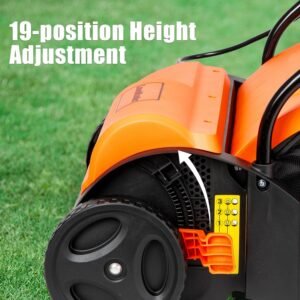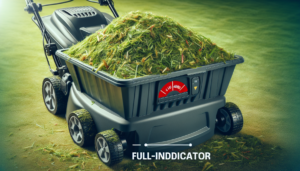
If you’re a fan of a lush and healthy lawn, then you’ve probably heard about the benefits of overseeding. But what if you have an electric lawn mower? Can you still achieve that perfect lawn without switching to a gas-powered machine? The answer might surprise you. In this article, we’ll explore the possibility of using an electric lawn mower with an attachment for lawn overseeding, and discover if it’s a viable option for maintaining a thriving and beautiful lawn. So, let’s dive in and find out!
Can You Use an Electric Lawn Mower With an Attachment for Lawn Overseeding?

Introduction
When it comes to maintaining a beautiful and healthy lawn, regular maintenance is key. One important aspect of lawn maintenance is overseeding, which involves planting new grass seeds to fill in thin or bare patches on your lawn. If you own an electric lawn mower and are wondering if you can use it with an attachment for lawn overseeding, you’re in luck! In this article, we will explore the advantages of using an electric lawn mower and discuss the considerations for lawn overseeding. We will also delve into the different types of attachments available for overseeding and provide you with step-by-step instructions on how to overseed your lawn using an electric mower. So let’s get started and learn how you can achieve a lush and beautiful lawn with the help of your electric mower!
Understanding Lawn Overseeding
Before we dive into the specifics of using an electric mower for overseeding, let’s first define and understand the concept of overseeding. Overseeding is the process of planting new grass seeds on an existing lawn to improve its density, fill in bare spots, and promote a thicker and healthier turf. By introducing new grass seeds, you can enhance the overall appearance of your lawn and make it more resistant to weeds, diseases, and environmental stressors. Overseeding is typically done during the cooler months of the year when the soil temperatures are optimal for seed germination.

Advantages of Using an Electric Lawn Mower
Now that we have a basic understanding of overseeding, let’s explore the advantages of using an electric lawn mower for this task. Electric lawn mowers have gained popularity in recent years due to their numerous benefits. Here are some advantages of using an electric mower for overseeding:
Low maintenance and operating cost
Electric lawn mowers are known for their low maintenance requirements and operating costs. Unlike gas-powered mowers, which require oil changes, spark plug replacements, and regular fuel refills, electric mowers are relatively maintenance-free. They also eliminate the need for purchasing and storing gasoline, further reducing the operational costs.
Environmentally friendly
If you’re conscious about reducing your carbon footprint, an electric lawn mower is the way to go. Electric mowers produce zero emissions during operation, contributing to cleaner air and a healthier environment. By using an electric mower for overseeding, you can ensure that your lawn maintenance practices align with your commitment to sustainability.
Ease of use and maneuverability
Electric lawn mowers are generally lighter and more compact than their gas-powered counterparts, making them easier to maneuver around your yard. Their cordless models provide even greater maneuverability without the hassle of tangling cords. This ease of use and maneuverability translates to a more efficient overseeding process, allowing you to cover larger areas with less effort.
Quieter operation
One of the standout features of electric lawn mowers is their quiet operation. Unlike the loud and noisy gas-powered mowers, electric mowers operate at significantly lower noise levels. This makes them a great choice for those living in noise-sensitive neighborhoods or for individuals who prefer a quieter lawn care experience.
Considerations for Lawn Overseeding
Now that we’ve discussed the advantages of using an electric mower, let’s shift our focus to the considerations for lawn overseeding. Before you begin overseeding, it’s important to assess the current condition of your lawn, choose the right grass seed, prepare your lawn, and address any existing weed or pest issues. Here are some key considerations to keep in mind:
Assessing the current condition of the lawn
Take a close look at your lawn and identify any thin or bare patches that need overseeding. Consider factors such as the overall health of the grass, the type of grass currently present, and the level of weed infestation. This assessment will help you determine the appropriate steps to take for a successful overseeding process.
Choosing the right grass seed
Selecting the right grass seed is crucial for achieving desirable results. Consider factors such as the climate in your region, the amount of sunlight your lawn receives, and the intended use of your lawn. Different grass varieties have different characteristics, such as tolerance to shade, wear resistance, and drought resistance. Choose a seed blend that suits your specific lawn needs.
Preparing the lawn for overseeding
Prepare your lawn by mowing it at a slightly lower height than usual and removing any debris or weeds. This will create an ideal environment for the new grass seeds to establish themselves. If your lawn has excessive thatch, consider dethatching or power raking to alleviate the buildup and create better seed-to-soil contact.
Dealing with existing weeds and pests
Before overseeding, it’s important to address any weed or pest issues in your lawn. Remove any visible weeds manually or use an appropriate herbicide to eliminate them. If pests such as grubs or insects are present, consider treating your lawn with suitable products to ensure the newly seeded areas are not compromised.
Understanding watering and maintenance requirements
Proper watering and maintenance are crucial for successful overseeding. Ensure that your lawn receives sufficient moisture without overwatering, as this can lead to disease and poor germination. Follow a regular watering schedule and provide the new grass seeds with the right amount of water to facilitate germination and establishment.

Types of Attachments for Lawn Overseeding
Now that we understand the considerations for overseeding, let’s explore the different types of attachments available for lawn overseeding. These attachments are designed to work with various types of mowers and can make the overseeding process more efficient and effective. Here are some commonly used attachments:
Overview of overseeding attachments
Overseeding attachments come in various forms and serve different purposes. They can be broadly categorized into dethatching and power raking attachments, seed spreader attachments, and slit seeder attachments. Each attachment type has its own benefits and is suitable for specific overseeding requirements.
Discussing dethatching and power raking attachments
Dethatching and power raking attachments are designed to remove excessive thatch and debris from your lawn. They utilize rotating blades or tines to loosen and lift the thatch, allowing for better seed-to-soil contact. These attachments can be particularly useful if your lawn has a thick layer of thatch or if you want to improve the overall health of your lawn while overseeding.
Exploring seed spreader attachments
Seed spreader attachments, also known as broadcast spreaders, are used to evenly distribute grass seeds across your lawn. These attachments feature a hopper that holds the seed and a mechanism that disperses it in a controlled manner. Seed spreaders are ideal for overseeding large areas and ensure that the seeds are distributed evenly, leading to a more uniform germination and growth.
Examining slit seeder attachments
Slit seeder attachments are designed to create shallow grooves in the soil and deposit seeds directly into these grooves. This attachment type ensures excellent seed-to-soil contact and maximizes seed germination rates. Slit seeders are highly effective for overseeding thin or bare patches and provide optimal conditions for seed establishment.
Using an Electric Lawn Mower for Overseeding
Now that we have a good understanding of overseeding attachments, let’s discuss whether an electric lawn mower can be used for overseeding and explore the benefits and limitations.
Compatibility of electric mowers with overseeding attachments
Most electric mowers are compatible with overseeding attachments, although it is essential to check the manufacturer’s recommendations and guidelines for your specific model. Some electric mowers may have specific requirements or limitations when it comes to using attachments, so it’s important to ensure compatibility before investing in any overseeding attachment.
Benefits and limitations of using an electric mower for overseeding
Using an electric mower for overseeding offers several benefits. Electric mowers are typically lighter and more maneuverable, making them easier to use with overseeding attachments. They also produce cleaner and quieter operation, minimizing disturbance to both you and your neighbors. However, electric mowers may have limitations in terms of power and battery life, so it’s important to consider the size of your lawn and the runtime of your mower before embarking on the overseeding process.
Essential features to look for in an electric mower for overseeding
If you plan to use an electric mower for overseeding, there are a few essential features to look for. Make sure your mower has sufficient cutting width and adjustable cutting heights to accommodate overseeding attachments. Look for a battery-powered mower with a long runtime or consider a corded electric mower if you have a smaller lawn. Additionally, opt for a model with a detachable or foldable handle for easy attachment installation and storage.
Steps for Overseeding with an Electric Lawn Mower
Now that we have covered the considerations and compatibility, let’s go through the step-by-step process of overseeding your lawn with an electric lawn mower:
Preparation before overseeding
Start by preparing your lawn. Mow the existing grass at a slightly lower height, remove any weeds or debris, and dethatch if necessary. Water your lawn a day or two before overseeding to ensure the soil is adequately hydrated.
Adjusting the electric mower for overseeding
If your electric mower has adjustable cutting heights, set it at the appropriate height recommended for overseeding. Install the overseeding attachment according to the manufacturer’s instructions, ensuring that it is securely attached. If using a seed spreader attachment, fill the hopper with the appropriate amount of grass seed.
Spreading the grass seed evenly
Begin mowing your lawn at a steady and consistent pace, ensuring that the seeds are being evenly dispersed. If using a slit seeder attachment, the seeds will automatically be deposited into the grooves created by the attachment. If using a seed spreader attachment, ensure that the seeds are being evenly spread across the lawn.
Proper mowing techniques during overseeding
When overseeding with an electric mower, it’s crucial to maintain a consistent mowing height and avoid cutting the newly seeded areas too short. Adjust the cutting height to prevent scalping the grass, which can hinder seed germination and establishment. Aim to remove no more than one-third of the grass blade length during each mowing session.
Post-overseeding maintenance and care
After overseeding, continue to water your lawn regularly, ensuring that the soil remains consistently moist but not waterlogged. Avoid heavy foot traffic on the newly seeded areas to prevent seed displacement or damage. Follow a regular mowing and fertilization schedule to nurture the new grass and promote its healthy growth.
Maintenance and Care
To ensure the longevity and effectiveness of your overseeding attachments and electric mower, proper maintenance and care are essential. Here are some tips to keep your equipment in optimal condition:
Cleaning and maintenance of overseeding attachments
Regularly clean your overseeding attachments after each use to prevent seed buildup and debris accumulation. Remove any excess grass seed and rinse the attachments with water. Check for any damage or wear and tear, and replace or repair any components as needed. Properly store your attachments in a clean and dry area to prevent corrosion or damage.
Regular maintenance of the electric mower
Follow the manufacturer’s guidelines for regular maintenance of your electric mower. This may include cleaning the mower deck, sharpening or replacing the mower blades, and inspecting the battery or cord connections. Keep the mower free of debris and grass clippings and ensure that all components are functioning properly.
Proper storage and winterization
When the overseeding season is over, ensure that you store your electric mower and attachments appropriately. Clean the mower thoroughly, remove the battery if applicable, and store it indoors in a dry and secure location. If you live in an area with freezing temperatures, consider winterizing your mower to prevent cold-weather damage.
Tips and Tricks for Successful Lawn Overseeding
To wrap up our comprehensive guide, here are some additional tips and tricks to ensure a successful lawn overseeding process:
- Conduct a soil test before overseeding to identify any nutrient deficiencies or pH imbalances that may hinder seed germination.
- Consider core aerating your lawn to alleviate soil compaction and improve seed-to-soil contact.
- Choose a high-quality grass seed blend that matches the existing grass type to achieve a seamless and cohesive aesthetic.
- Water your lawn consistently but avoid overwatering, as this can lead to shallow root development and increased susceptibility to diseases.
- Adjust your watering schedule as the new grass begins to establish, gradually reducing frequency and increasing the duration of watering sessions.
- Avoid applying weed control products immediately after overseeding, as they may interfere with seed germination and growth.
- Be patient and give your newly seeded lawn time to establish. It may take several weeks for the new grass to fill in and become densely populated.
Conclusion
Using an electric lawn mower with an attachment for lawn overseeding is not only possible but also offers several advantages. Electric mowers are low maintenance, environmentally friendly, easy to use, and quieter compared to gas-powered alternatives. By following the proper steps and considering the essential factors for overseeding, you can achieve a lush and healthy lawn with the help of your electric mower and the appropriate attachments. Remember to always read the manufacturer’s instructions, choose the right grass seed, and provide the necessary care and maintenance to ensure the long-term success of your overseeded lawn. So go ahead and enjoy the process of overseeding your lawn with your trusty electric mower, and soon you’ll be rewarded with a vibrant and revitalized landscape. Happy overseeding!






